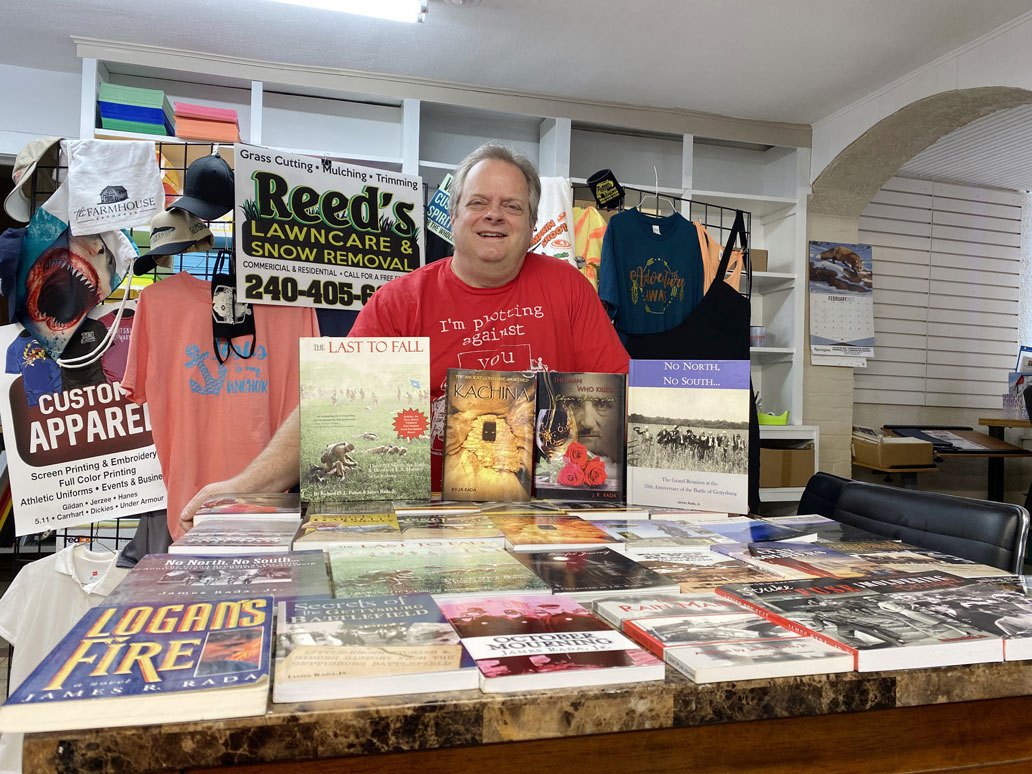Blair Garrett
Storytelling is something humans have done since the beginnings of communication.
The ability to harness a whirlwind of ideas and narrow it down into a digestible story that pulls a reader’s mind into the author’s imagination is one of those rare-to-find skills.
An effective storyteller crafts and creates gripping content that engages readers in a way that keeps them looking for more.
James Rada Jr., 54, of Gettysburg, knows a thing or two about storytelling.
“I’ve always wanted to be a writer,” Rada said.
To date, Rada has published over 30 books, with three becoming bestsellers in 2020.
Rada’s journey to reach where he is has been a long one, but he’s picked up a lot of steam since his launch in the mid-90s.
“My first novel was published in ‘96,” Rada said. “I started working as an indie publisher in 2000, and I really liked that, so I stuck with it.”
Over the years, Rada has written about a variety of subjects. Anything from historical fiction to horror to young adult stories to the Civil War era history has caught his eye.
Rada first tasted success with his premier historical novel, titled Canawlers. Canawlers details the life of a family navigating the hardships of the Civil War on the C&O Canal. The C&O Canal ran between the Confederate and Union armies during a particularly volatile time.
During the inception of Canawlers, Rada’s focus relied on covering places he could visit and draw inspiration. Several of his books feature places about which he has intimate knowledge. Secrets of Catoctin Mountain, Secrets of the Gettysburg Battlefield, and Canawlers are all great examples of that first-person experience manifesting into an interesting and riveting story.
Great artists, creators, and storytellers often develop ideas for future work off of untold loose ends in their books, chord progressions that didn’t provide the right melody for a song, or projects where all of the pieces didn’t quite fit. Readers of Rada’s books would often ask what happened to characters outside of his story’s focus. That interest sparked creative fires that led to follow-up books.
“My goal was to tell the story of the canal,” Rada said. “Once I started doing the events, people would come up to me and say, ‘Well, what happened with George, and what happened with Alice and David, and did they get together?’” Rada continued. “I hadn’t really thought about that because that wasn’t the purpose of the story, so I had to start thinking about that, and that’s where the other canal books came in.”
These burning questions needed answers, and the pen hit the paper. Rada’s second and third iterations of some of his most popular stories are contoured to tell his complete story, beginning to end, even if it wasn’t the initial scope of the first volume.
Rada has made plenty of adjustments with his books, figuring out what works and what doesn’t work. With the increasing market for electronic books and the consumption of online media, Rada made a change that propelled his novels to the next dimension.
“Last year, I pivoted from what I was doing,” Rada said. “I started looking more at ebooks, marketing what I had, and I got a mentor.”
Rada’s efforts to expand his work to the masses paid off, and it reflected with more sales, more visibility, and more confidence going forward.
“The first book I did after that was Strike the Fuse, which was the second book in a trilogy,” he said. “That one got up to number 81 in the free Kindle market, and the top 300 in the paid Kindle market, and number 1 in six different categories on Kindle.”
The train didn’t stop there, though, as Rada’s Four Score & Seven Stories Ago: A Gettysburg Writers Brigade Anthology took off shortly after, reaching heights Rada hadn’t expected.
“An anthology from my writers group got into the top 10 in three categories after some marketing. I relaunched the canal books, and all of those made it into the top 10 in multiple categories, and the top 10,000 on Amazon. That doesn’t sound like a lot, but when you realize there are 33 million books on Amazon, it’s something,” Rada said.
There are big plans in the works for Gettysburg’s newest best-selling author, but he plans on sticking to what excites him the most to write about.
“I’ve always written stories that appealed to me,” Rada said. “If you’re not interested in what you’re writing about, then your reader is not going to be interested in it.”
Whether it’s mystery that captivates you or history that fascinates you, Rada has something for just about everyone, and there is always more to come. “I’ve got a long way to go, but I feel like I’m really catching some traction now.”
Rada is a writer and contributing editor for The Catoctin Banner Newzine. He also contributes to multiple other publications. You can find his books and novels online in paperback and ebook format or visit jamesrada.com.

Jim Rada displays his dozens of short stories, novels, and thrillers that he has written over his career.

